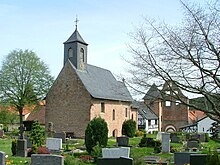Eva von Leiningen-Westerburg
Eva von Leiningen-Westerburg , often also Countess Eva von Neuleiningen (* 1481 ; † February 23, 1543 ) was a ruling Countess of Leiningen who went into the Palatinate Volksgut .
Origin and life
She was the daughter of Count Reinhard I. von Leiningen (1453-1522) and his first wife Anna von Eppstein, Countess von Königstein († 1483). After her death, the father married Zymeria von Sayn († 1499) in the second marriage . Nine children arose from both marriages. Eva had 2 brothers from the same paternal relationship, namely Philipp (1483–1522) and Reinhard (1479–1540). The latter officiated as dean of the cathedral in Trier and was excluded from the inheritance as a clergyman. Philipp died shortly after his father. The remaining children came from the second marriage, of them the half-brother Kuno (1487–1547) was to become the ruling count and successor to the father.
Eva von Leiningen-Westerburg objected to this and demanded the payment of the high dowry of her deceased mother or compensation for it. Since Kuno could not pay them off, he left part of the County of Leiningen-Westerburg to the unmarried half-sister Eva for life. After her death, he should revert to him or his heirs. According to this agreement, Countess Eva received Neuleiningen Castle as her residence in 1523 , as well as the villages of Grünstadt , Sausenheim , Asselheim , Albsheim an der Eis , Obrigheim , Kirchheim and Bissersheim . In this area she ruled until the end of her life as the ruling countess.
She used to run the household for her widowed father for over 20 years and is described as pious, prudent and resolute. The story that Countess Eva made part of the Palatinate national estate easily fits into this characteristic. Friedrich Wilhelm Hebel included it in his collection of sagas from the Palatinate and Paul Münch wrote a well-known dialect poem about it. In the Palatinate Peasants' War in 1525, the regent is said to have wisely not put up any resistance to the pillaging heap, but instead let them into Neuleiningen Castle, where they could eat and drink as much wine as they wanted. Countess Eva even served the looters herself, either voluntarily or by force. In any case, the farmers withdrew without damaging the castle. Shortly before, they had been in Altleiningen and had laid the neighboring castle to rubble and ashes.
In 1537 she set up a hospital foundation for her territory in honor of the “Most Holy Trinity” and the “Queen of Heaven” , which she also sponsored once again in her will. It was intended to provide for “seven pious, honorable and poor people” , one from each of the seven Liningian towns belonging to them. For this purpose , a hospitium was set up in Grünstadt, in Hauptstrasse, opposite the town hall , where they were allowed to live. Each of these poor should be given a daily portion of wine, half a pound of meat and bread to feed themselves. The foundation was expanded to include the entire County of Leiningen-Westerburg in 1567 and existed well into the 19th century.
Countess Eva died in 1543 and was buried in the Count's crypt of St. Jakob in Höningen . Their territory fell back to the half-brother Kuno. Her half-sister Barbara von Leiningen officiated between 1546 and 1576 as abbess of the Marienberg monastery in Boppard .
Every year since 1950 , a wine countess from the Leiningerland has been crowned in Grünstadt as the representative of local viticulture. According to the city administration's website, the model for this position is the historical figure of Countess Eva von Neuleiningen.
literature
- Johann Georg Lehmann : Documented history of the castles and mountain palaces in the former districts, counties and lordships of the Bavarian Palatinate , Volume 3, pages 274 u. 275, Kaiserslautern, 1863
- Walter Lampert: 1100 years of Grünstadt , Grünstadt city administration, 1975, page 61
- Friedrich Wilhelm Hebel : Palatine legends , Lincks-Crusius publishing house, Kaiserslautern, 1966, p. 78
- Franz Fahnemann: Cornucopia of Westmark , Westmark-Verlag, Ludwigshafen, 1942, pp. 16-18
- Paul Münch : Die Pfälzisch Weltgeschicht , Verlag Verlag Lincks-Crusius, Kaiserslautern, 1965, pp. 132-138
Web links
- Official website on the history of Neuleiningen, with a mention of Countess Eva
- Website for the Leiningerland-Museum Neuleiningen, with reference to Countess Eva
Individual evidence
- ^ Website on Neuleiningen Castle, with mention of the transfer to Countess Eva
- ↑ Online view of the poem
- ↑ History of the castle saved by Countess Eva
- ^ Intelligence Gazette of the Rhine District , No. 155, of September 8, 1822, p. 651 u. 652 of the year; Digital view
- ^ Michael Frey : Attempt at a geographical-historical-statistical description of the royal Bavarian Rhine district , Volume 2, p. 287, Speyer, 1836; Digital view
- ↑ Website for the Jakobskirche Höningen
- ^ Website of the city administration of Grünstadt, to the wine countess
| personal data | |
|---|---|
| SURNAME | Leiningen-Westerburg, Eva von |
| ALTERNATIVE NAMES | Countess Eva von Neuleiningen |
| BRIEF DESCRIPTION | Countess von Leiningen, person of regional history and literature |
| DATE OF BIRTH | 1481 |
| DATE OF DEATH | February 23, 1543 |

